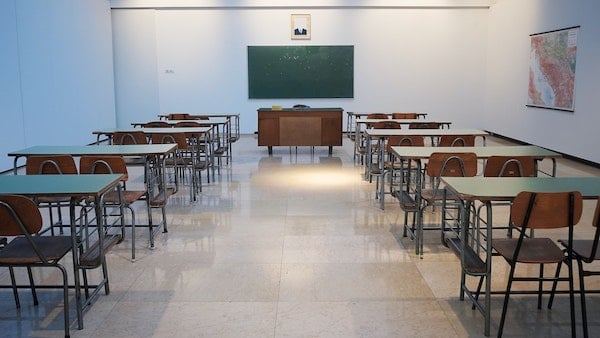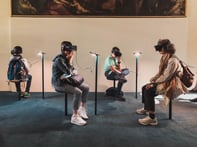Published on
Could “Emergency Remote Teaching” Accelerate a Re-Envisioning of Active Learning Through an Online Environment at Scale?

Active Learning is often linked to Jean Piaget’s theory of cognitive development wherein the learner builds an understanding, and Dewey’s theory of progressive learning through experiential assimilation. As described by Dewey –
“The teacher and the book are no longer the only instructors; the hands, the eyes, the ears, in fact the whole body, become sources of information, while teacher and text-book become respectively the starter and the tester. No book or map is a substitute for personal experience; they cannot take the place of the actual journey. The mathematical formula for a falling body does not take the place of throwing stones or shaking apples from a tree.”[1]
From the times of Akademia when a group of “students” surrounding Plato learned from his lectures punctuated by dialogue and debates, a special emphasis has been placed on “learning by doing” as opposed to the transference of knowledge through passive lectures. The very best instructors today engage students at various levels of enquiry and discovery, integrating and supplementing lectures with numerous activities focused on developing skills resulting in students “doing things and thinking about what they are doing.”[2]
The division of students in a class into smaller groups allows them to engage in intense discussion, projects and even experiments, which can substantially enhance active learning. This practice results in greater engagement and interaction between the instructor and their students and between the students themselves not just through exploratory and experiential activities but through deeper dialogue and debates otherwise impossible in the large traditional class. This structure also allows the instructor to more closely engage with the individual student, identifying where additional help or guidance might be needed and giving feedback in real time often through an activity rather than just through comments and grades on assignments. While these activities describe aspects of active learning, it should be noted that they follow the seven principles of good teaching practice enumerated by Chickering and Gamson[3], with the modified settings enabling learning by discovery and enquiry.
The challenge in the traditional sense is that increasing enrollments, growing student-to-faculty ratios, a focus on time-based learning irrespective of desired outcomes, and even a lack of flexible space make the routine incorporation of active learning–even for the most committed faculty member–difficult in most courses at the majority of colleges and universities. Small liberal arts colleges and some dedicated polytechnics by their very structure enable true active learning, but in the vast panoply of higher education institutions, they are the exception rather than the rule. Thus, while active learning is desired, our traditional constructs along with increased numbers of students have resulted in the lecture remaining the dominant mode of teaching. Innovative and dedicated faculty, however, have found ways to integrate active learning into their curricula even in large classes using innovative activities, digital technology and flipped classrooms. The challenge, of course, is its expansion to all courses irrespective of size, enabling the advantages of small groups even as scale and size continue to increase. While the implementation of true online learning–adaptive, continuous feedback and increased interaction–could in fact address a number of these aspects, a myriad of concerns–real and perceived–as well as technological considerations have slowed its adoption even as a supplement to the traditional classroom.
Online education by and large still carries with it a negative connotation for a significant part of higher ed. Yet the rapid transition to emergency remote teaching forced by the COVID-19 pandemic has resulted in the lowering of some psychological barriers to online learning, as faculty moved rapidly to engage students through a range of tools catalyzed by necessity. The results, as could be expected, ranged from spectacular enhancements of the learning environment using digital technologies and tools, to the implementation of live or recorded lectures viewed synchronously or asynchronously, providing the bare minimal levels of interaction expected in a classroom.
While justifiable concerns have been raised about the quality of learning resulting from the latter, the transition has also resulted in improving active learning, in some cases. Given this transition, it may well be time to re-examine precepts of online education, not just as a mode of increasing access and flexibility but also as a mechanism to increase active learning and enhance individual attention. Towards that end, it is instructive to consider a description of active learning provided by the University of Florida Center for Instructional Technology and Training:[4]
“Active learning is a learning technique that challenges students to engage through mental contributions, hands-on activities, and/or the process of investigation, discovery, and interpretation. Incorporating active learning strategies into your classroom gives you the ability to watch how your students think and learn, identify areas where further explanation or clarity is needed, provide real-time feedback, and enrich the overall quality of learning for your students”
It is also helpful to map this to the ease of offerings through the online, or digital, modes of engagement.
Directed rather than linear activities
Classroom-based instruction, especially in large classes, relegates learning to a linear process led by the instructor with little flexibility for the learner who is either advanced or the one who needs more attention to master a topic. In the online world, this can be individualized, allowing the student to determine a path per intellectual need, augmented by individualized information that enables further discovery and interaction on the path to mastering the topic. Lectures in the traditional sense cannot be halted to allow for individualized attention. Adaptive learning techniques used in the digital world, especially when integrated with activities such as specific exercise sets or focused interaction with sub-groups of students having the same difficulty, can be powerful tools to advance knowledge.
Simulation-based learning
We learn not just by listening but by discovering paths between options and inquiring about the “what-ifs” and “why-nots.” The use of simulation tools easily incorporated into the online environment enables students to explore multiple what-if scenarios and learn about the right answer or even alternate answers to the same question. While these tools can and have been successfully used in the traditional setting, the range of parameters involved is necessarily restricted. These restrictions are lifted in the online environment with each simulation conceivably being adapted to the individual learner or group in terms of input and boundary parameters.
Exploration and discovery during instruction
The elucidation of a topic or exploration around it is limited to asking question during the traditional lecture. Appropriately designed online courses intrinsically promote active learning, as the student can “explore” the content at their own pace and learning style while interacting with supplementary modules, which themselves enhance discovery and retention. In the online environment, even one based on asynchronous delivery, the student has the ability to pause the linearity of instruction to further explore the topic of their choosing, using collated materials provided by the instructor or by browsing through online resources. The use of chatrooms, chatbots and other messaging tools allow for a significantly greater level of engaged interaction and active learning. Additionally, there is no doubt that the online setting provides more opportunities for interaction for the shy student and for the student who needs more time to absorb the material before asking a question or responding to a query. Time and method of interaction are far more inviting in the online environment.
Performing hands-on experiments in a virtual lab
Traditionally, laboratory sections have enabled discovery by allowing students to perform experiments to increase their understanding about phenomena (e.g. chemical reactions) or situations (e.g. operating a nuclear reactor or turbine). Over the years, aspects such as cost considerations, increases in class sizes and safety concerns have decreased the students’ ability to use these in a modality catalyzing learning through enquiry and discovery. They may be run as demonstrations or in group settings with only one or two students actually getting the hands-on experience with others are involved, at best, as highly engaged spectators. The online environment enables all to be engaged, varying the experiment by individual, allowing for multiple runs at a student’s own pace, and even learning through modes inaccessible in the traditional classroom – such as a nuclear reactor going critical.
Rapid and individualized feedback
Feedback has traditionally been given through comments and grades on assignments or through discussion during tutorial sessions (which are becoming rarer because of increasing class sizes and resource constraints). The ability to provide feedback almost instantaneously through adaptive learning modules and specially designed exercises that provide hints for self-correction provides significant advantages. Further, additional supplementary material can be provided to the student to enable them to build up their expertise. The ability to individualize this level of attention in an active learning setting is not easy and needs specific instructional design, but once implemented, it can be scaled to very large numbers of students, removing the resource constraints that will always exist in the face-to-face mode. In many ways the virtual tutor, augmented by interactions with instructors and online coaches, can replicate the very powerful “hand on the shoulder” encouragement only possible in individual or small group settings in the traditional sense.
Online repetition and redirection
Students often learn through repetition and receiving personalized, real-time feedback. The use of dynamic facts to change parameters in a problem/exercise, linking results to actual situations that can be described in an online setting, can allow students to not just overcoming a “block” but to access validating learning through repetition with modifications. This can be especially useful in mastering complex processes that need repetition and can be repeated at scale with every student in an online setting.
Virtual immersive visits
While the widespread use of augmented reality (AR) and Virtual Reality (VR) are still not common, the technology does provide for unique mechanisms of student engagement that enable active learning. Consider a class’s ability to engage in the Louvre, the National Air and Space Museum or the National Museum of African American History and Culture, for example, as part of a class, interacting with exhibits and being “transported” historically and socio-culturally into a world that otherwise is only available through books and videos. This level of engagement is invaluable to learning through true discovery. Further, experiences critical to students’ educational development in specific disciplines heretofore restricted to a very small number of students, such as being part of an archeological dig, can be available to all, thereby changing what it means to truly experience and learn from living history.
Group interactions
Learning often happens best through interactions between students in small groups, which has led higher education to use group activities and projects in traditional courses. Just as with laboratories, these are becoming more difficult to expand face-to-face because of increasing numbers and decreasing resources. The online world, however, allows for virtual groups to be conducted flexibly, allowing instructors to not only attend to each group but to also enable different groups to form both formally and informally in a course. Student-to-student interaction through intense directed discussions and debates– activities involving shared responsibility and contributions–add to peer-to-peer learning unrestricted by constraints of space (as in the physical world where classroom space for group activities is often an impediment) or time (since groups can now meet at times convenient for members in a group unconstrained by universal schedules).
Many of the aspects described above have been incorporated almost overnight into courses as a result of the pandemic, and these and others not described here will undoubtedly be adopted over time both in the online and traditional modes of instruction. Nothing discussed here should be taken to suggest that face-to-face instruction is undesirable, nor that it will not be continuously improved upon. However, higher ed undeniably has a responsibility to society to enable increased access and flexibility, allowing greater numbers to gain from the promise of higher education, and now has the ability through digital technology to enable a reasonable alternative to the long-held physical ideal (the learned teacher-scholar surrounded by a small group of students actively engaged in the dissemination and creation of knowledge). The question for us is whether we will use this opportunity to move in that direction post-COVID-19 for the benefit of all those desiring knowledge irrespective of socio-economic background, stage of learning, and social ability, or just return to business as usual – passive assimilation through lectures or continue to increase discovery and enquiry through online facilitated active learning, re-envisioning a virtual form of Plato’s Academy.
References
[1] J. Dewey and E. Dewey, Schools of To-morrow, 1915. Available at http://www.gutenberg.org/files/48906/48906-h/48906-h.htm
[2] CC Bonwell and JA Eison, Active Learning: Creating Excitement in the Classroom, 1991. ASHE-ERIC Higher Education Report. Available at https://files.eric.ed.gov/fulltext/ED336049.pdf
[3] AW Chickering and ZF Gamson, Seven Principles for Good Practice in Undergraduate Education, March 1987. AAHE Bulletin 3-7.
[4] https://citt.ufl.edu/resources/student-engagement/adopting-active-learning-approaches/
Disclaimer: Embedded links in articles don’t represent author endorsement, but aim to provide readers with additional context and service.
Author Perspective: Educator



